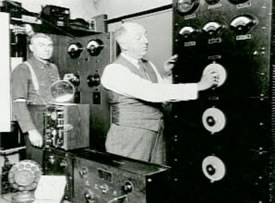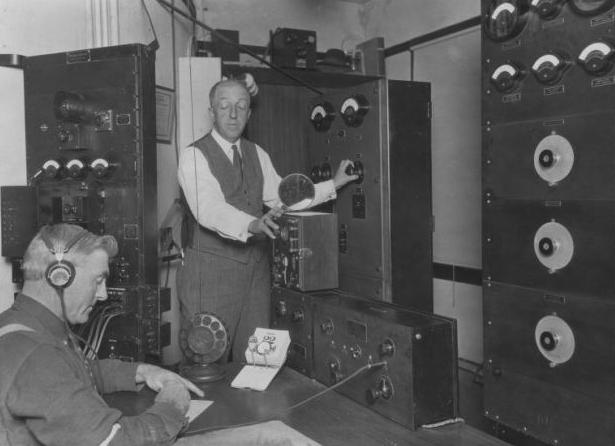
KQW Radio, San Jose
“The Story Of KQW”
Saturday, November 10, 1945
Featuring Ken Ackerman,
Clarence “Clancy” Cassell and Jack Webb

The widely-acknowledged inventor of radio broadcasting, Charles David (Doc) Herrold, often referred to as “Prof Herrold” by his students, is heard in this program commemorating the thirty-sixth anniversary of San Jose’s KQW (now KCBS, 740 AM, in San Francisco).
Intended to trumpet KQW’s rightful place as the world’s first radio station to broadcast programming to a general audience on a regular basis, the program was aired the same week that the industry was saluting the first broadcast of Pittsburgh’s KDKA, which took place on the night of November 2, 1920.

Longtime KQW/KCBS announcers and newsmen Ken Ackerman and Clancy Cassell serve as the narrators of the dramatic “Story of KQW,” which features a young radio actor named Jack Webb in the role of young Doc Herrold. Webb would go on to greater acclaim as Sgt. Joe Friday on the long-running radio and television series “Dragnet.”
Two other actors heard in the broadcast, Dick Ellers and Herb Ellis — each of whom plays multiple roles in this broadcast — would also be part of Webb’s repertory company on productions such as “Dragnet,” “Pat Novak For Hire” and “Pete Kelly’s Blues.”
The script was written by Roy Grandey, who also produced and directed the program at the behest of KQW owner Ralph Brunton and station manager Charles L. McCarthy, who were strong proponents of KQW’s place in broadcasting history.
In a 1996 interview with Gordon Greb, Grandey explained:
“I was given several files and there must have been the equivalent of about 50 pages that would go into a press book. They were articles about instances of what happened from those days — the early days — a lot of different biographies of Doc Herrold and so forth. … There was no controversy in the research material at all. It was very straightforward … this pioneer did it!”
(An audio presentation by Professor Greb on his re-discovery of Doc Herrold and his landmark station’s early achievements is included below on this page.)
Doc Herrold, Ken Ackerman and former KQW owner Ralph Brunton were inducted into the Bay Area Radio Hall of Fame in 2006 as members of the first group to be enshrined.

The Story of KQW (November 10, 1945)
The actual broadcast of the KQW 30th anniversary production, digitally re-mastered from the transcription disc. Narrated by Ken Ackerman and Clarence “Clancy” Cassell; written, directed and produced by Roy Grandey; Don Victor, associate director; cast including Dick Ellers, Herb Ellis, Dick Glyer and Jack Webb; sound effects by Don Creed; engineering by Paul Smith.

About Doc Herrold
By Marty Cheek
Born in Illinois on November 16, 1875, Charles Herrold moved as a boy to Santa Clara Valley and grew up on his family’s San Jose farm. His young and inquisitive mind set upon creating new inventions. One of his earliest was a clock-driven telescope that held aim at the stars during astronomical observations.
After graduating from high school, Herrold attended Stanford University and studied physics and electricity. “Wireless” technology was still in its infancy, developed in 1895 by the Italian Guglielmo Marconi whose invention “telegraphed” messages over the airwaves.
Herrold, however, saw a greater potential for radiowaves than just a medium for sending the dots and dashes of Morse Code across the distances. He believed voices and music could also be transmitted. The radio pioneer saw the future potential.
With ambitions of fame and fortune, in 1900 Herrold founded an electrical manufacturing firm in San Francisco. Things went well until 1906 when a rather major earthquake hit the Bay Area early one April morning. Herrold lost everything but his dream.
He headed to Stockton to teach at a state technical college for a couple of years, then made his way back to San Jose in 1909. Here, he set up his electronics academy — the Herrold College of Wireless and Engineering. Students called him “Doc.”

Although his name is not as famous as Marconi’s, Doc Herrold’s work did add several significant contributions to wireless innovation. He built a spark gap transmitter attached to a carbon microphone. With this experimental device, he and his college’s students were able to send out relatively low-frequency 50-watt transmissions from San Jose’s seven-story Garden City Bank Building. (The Knight Ridder Building now occupies the downtown spot where it once stood.)
In those days, wireless technology was still in its infancy. So Herrold and his students had to spend their spare hours building simple crystal radio receivers for listeners to pick up their transmissions. Local folks were astonished to hear the words “This is the Herrold Station” and “San Jose calling” on the bulky receiver headsets they wore. The moment must have seemed magical for many.
Unfortunately, Herrold’s early transmitting device had a major headache. The carbon element burned out every couple of hours. Replacing it cut into transmission time. So, Herrold came up with a new transmitting contraption he called the “Arc Fone.” It was a series of six arc lights which generated high-frequency radio waves strong enough to carry voices and music longer distances.
The power-hungry Arc Fone required far more than 50 watts — the power of a light bulb. So Herrold “borrowed” the 500 volts he needed from San Jose’s streetcar line. He had to water-cool his microphone to keep it from incinerating.
In 1910, Herrold became the first broadcaster to play music across the airwaves on a regular basis. He made a “trade-out” deal for records with San Jose’s Sherman Clay music store. He played songs such as “My Old Kentucky Home” on a wind-up Victrola phonograph pointed at his crude microphone. He even became the first person ever to take song requests over the phone.

Herrold also pioneered radio contests presenting prizes to reward loyal listeners. And he became the first to broadcast current events and weather reports over his wireless station, setting the format for today’s radio and television news. He also came up with the concept of radio advertisement — commercials breaks — to pay for this exciting new technology.

Starting in 1912, Herrold’s wife Sybil Herrold became the first female disc jockey. Her “Little Hams” program was aimed at getting children involved in the radio experience.
Herrold’s wireless transmissions could be heard all over the Bay Area including in Morgan Hill, Gilroy and Hollister. In 1915, he transmitted music from San Jose to the Panama Pacific International Exhibition in San Francisco, giving amazed attendees at that world’s fair a taste of the technology.
In April 1917, the United States entered the Great War in Europe. For national security, Uncle Sam prohibited all non-government wireless transmissions. During the war years, Herrold’s Arc Fone became obsolete when Lee DeForest introduced his Audion tube — a more innovative technology that eventually led to computers.
In 1921, Herrold rebuilt his San Jose station. The government assigned it the call letters KQW. Facing hard financial times, he sold the enterprise in 1925. He stayed on as station engineer for a time until he was fired.
Herrold’s last years were marked by a series of humble jobs such as a security guard. He died on July 1, 1948, never truly enjoying the recognition he deserved as a genuine pioneer of radio.
Today, the term “wireless” is a technology buzzword again — this time connected to the Internet. Wireless is the next stage of high-tech’s evolution. It’ll soon be common for laptop computers to have widespread mobile connections to the vast ocean of World Wide Web information.
Here in the South Valley, people like Jim Carrillo see the potential of wireless Internet connection. Modeling Herrold’s first radio commercials, Carrillo’s innovative Morgan Hill-based company, Public Wi-Fi Project, sells advertisements to pay for the regional development of wireless Web technology.
Some historians consider Charles Herrold to be “the father of broadcast radio.” Although now virtually forgotten, his impact continues to spread like the radio waves he loved.
Remember his San Jose station KQW? Well, in 1949 it moved to San Francisco, the call letters changed to KCBS.
Marty Cheek is a regular columnist for the Gilroy Dispatch and is the author of “The Silicon Valley Handbook.” This article was reprinted with the generous permission of the author.

Gordon Greb: The Story of Doc Herrold (1959)
BONUS COVERAGE! San Jose State Professor Greb interviews Ray Newby, Joseph Cappa and Sybil Herrold True (Prof’s wife, and a pioneer broadcaster herself), each of whom was there fifty years earlier when Charles Herrold began broadcasting, as well as radio pioneer Lee De Forest, who attests to Herrold’s achievement. Both Professor Greb and Mrs. Herrold were inducted into the Bay Area Radio Hall of Fame in 2011.
RELATED EXHIBITS:
- The History of KQW from Voices Out Of The Fog


- Doc Herrold operating his San Jose station, 1912

- The Complete KCBS 740 Collection


- Charles Herrold Tribute Website

SOURCE MATERIAL: Background information for this presentation came in part from “Charles Herrold, Inventor of Radio Broadcasting” by Gordon Greb and Mike Adams
![]()

He lived at 1065 Bird Ave. San Jose, Ca?
Are you referring to Doc Herrold, LaDema?
his first radio station 6XE and 6XF are registered to 1065 Bird Ave. I lived there 9 years and while watering in the back close to the streetcar line he got his 500 watts from to transmit I would hear a humming and it was coming from the ground. I would follow the sound all the way to a bush. I even asked a few neighbors if they heard a humming and they said they did and it was coming from the ground around a bush and not always the same bush. I wondered what would cause the things that happened there that seemed paranormal but in fact I believe were residual from his tweeking the oscillation and the arc stuff he might have done with his portable station. The house was built in the early twenties. The next famous person who lived there was Clara Rees I think who was the iris garden hybrid lady and then Mariotts got her recipes and took over until the developer bought the land and built those homes and court. The streetcar line was behind the properties and were unused for many years as they were not economically profitable I think for Mr. Birds son. We had a tree farm for John Arnaz the chief arson investigator for santa clara county at that time and would access the tracks to enter the property from the back off Broadway there.
[…] The Story of KQW (Ken Ackerman and Clancy Cassell, hosts) […]
[…] Broadcast: The Story Of KQW (Nov. 11, 1945) […]